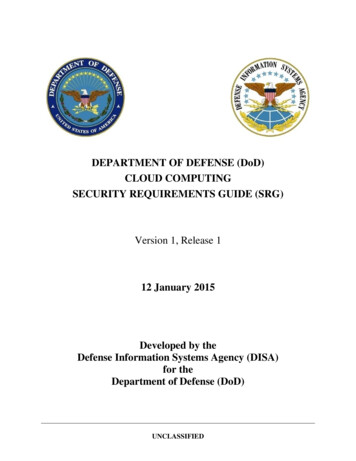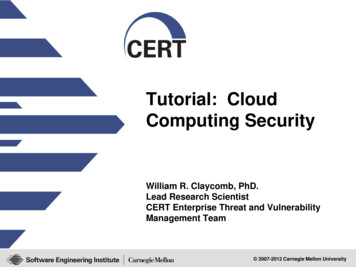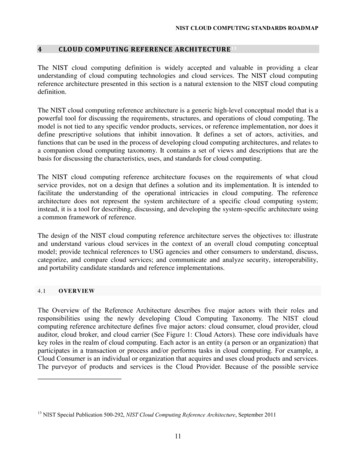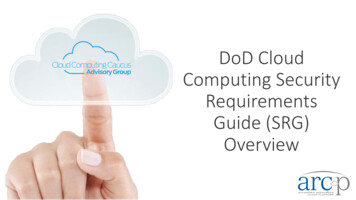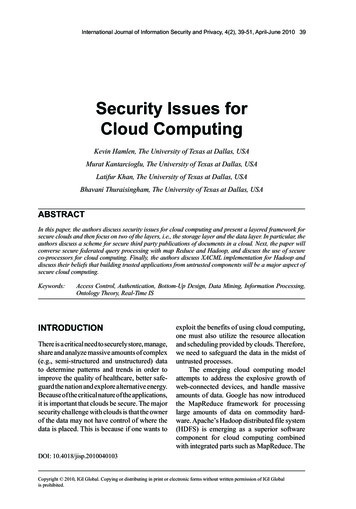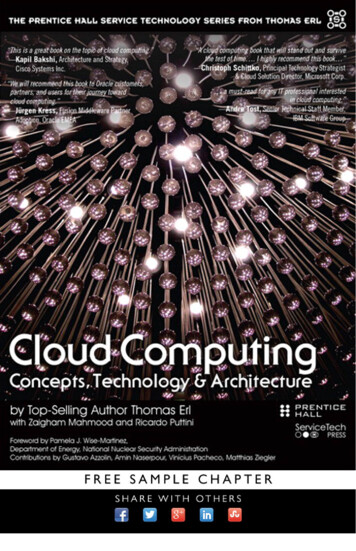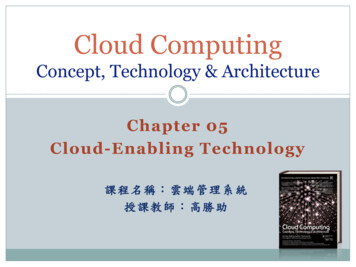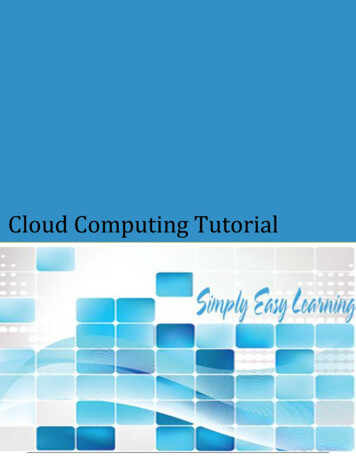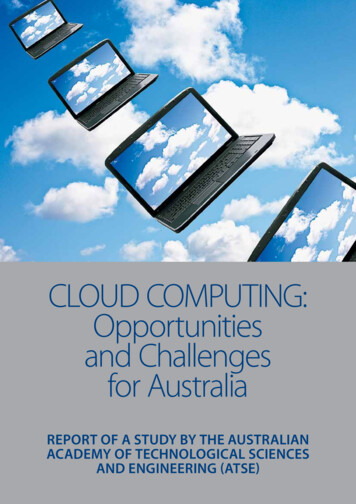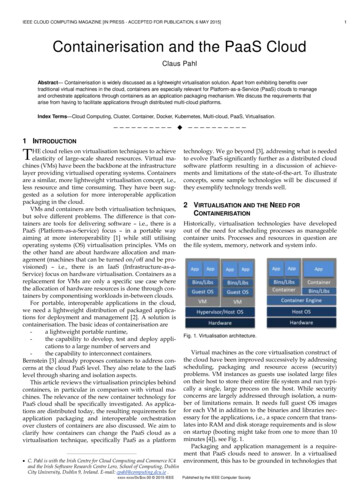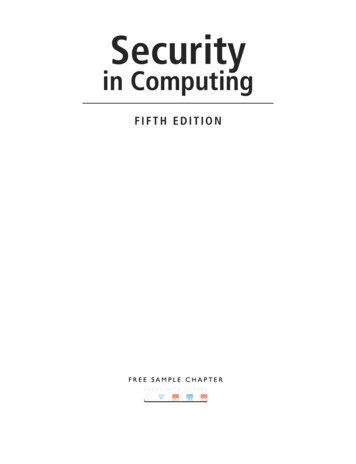
Transcription
Securityin ComputingFIFTH EDITIONFREE SAMPLE CHAPTERSHARE WITH OTHERS, '1i]
This page intentionally left blank
Securityin ComputingFIFTH EDITIONCharles P. PfleegerShari Lawrence PfleegerJonathan MarguliesUpper Saddle River, NJ Boston Indianapolis San FranciscoNew York Toronto Montreal London Munich Paris MadridCapetown Sydney Tokyo Singapore Mexico City
Many of the designations used by manufacturers and sellers to distinguish their products areclaimed as trademarks. Where those designations appear in this book, and the publisher wasaware of a trademark claim, the designations have been printed with initial capital letters orin all capitals.Executive EditorBernard GoodwinThe authors and publisher have taken care in the preparation of this book, but make noexpressed or implied warranty of any kind and assume no responsibility for errors oromissions. No liability is assumed for incidental or consequential damages in connectionwith or arising out of the use of the information or programs contained herein.Managing EditorJohn FullerFor information about buying this title in bulk quantities, or for special sales opportunities(which may include electronic versions; custom cover designs; and content particular to yourbusiness, training goals, marketing focus, or branding interests), please contact our corporatesales department at corpsales@pearsoned.com or (800) 382-3419.For government sales inquiries, please contact governmentsales@pearsoned.com.For questions about sales outside the U.S., please contact international@pearsoned.com.Visit us on the Web: informit.comLibrary of Congress Cataloging-in-Publication DataPfleeger, Charles P., 1948–Security in computing / Charles P. Pfleeger, Shari Lawrence Pfleeger, Jonathan Margulies.—Fifth edition.pages cmIncludes bibliographical references and index.ISBN 978-0-13-408504-3 (hardcover : alk. paper)—ISBN 0-13-408504-3 (hardcover : alk.paper)1. Computer security. 2. Data protection. 3. Privacy, Right of. I. Pfleeger, Shari Lawrence.II. Margulies, Jonathan. III. Title.QA76.9.A25P45 2015005.8—dc232014038579Copyright 2015 Pearson Education, Inc.All rights reserved. Printed in the United States of America. This publication is protectedby copyright, and permission must be obtained from the publisher prior to any prohibitedreproduction, storage in a retrieval system, or transmission in any form or by any means,electronic, mechanical, photocopying, recording, or likewise. To obtain permission touse material from this work, please submit a written request to Pearson Education, Inc.,Permissions Department, One Lake Street, Upper Saddle River, New Jersey 07458, or youmay fax your request to (201) 236-3290.ISBN-13: 978-0-13-408504-3ISBN-10: 0-13-408504-3Text printed in the United States on recycled paper at Courier in Westford, Massachusetts.First printing, January 2015Editorial AssistantMichelle HousleyProject EditorElizabeth RyanCopy EditorMary Lou NohrProofreaderLinda BegleyCover DesignerAlan ClementsCompositorShepherd, Inc.
To Willis Ware, a hero ofcomputer security and privacy.
This page intentionally left blank
ContentsChapter 1ForewordxixPrefacexxvAcknowledgmentsxxxiAbout the AuthorsxxxiiiIntroduction11.1What Is Computer Security?2Values of AssetsThe Vulnerability–Threat–Control lityIntegrityAvailabilityTypes of ThreatsTypes of Attackers810111316Harm21Risk and Common iesControlsConclusionWhat’s Next?Exercises2828313234vii
viiiContentsChapter 2Toolbox: Authentication, Access Control,and Cryptography362.12.22.32.4Chapter 3Authentication38Identification Versus Authentication38Authentication Based on Phrases and Facts:Something You KnowAuthentication Based on Biometrics: Something You AreAuthentication Based on Tokens: Something You HaveFederated Identity ManagementMultifactor AuthenticationSecure Authentication405365687070Access Control72Access PoliciesImplementing Access ControlProcedure-Oriented Access ControlRole-Based Access Control72758585Cryptography86Problems Addressed by EncryptionTerminologyDES: The Data Encryption StandardAES: Advanced Encryption SystemPublic Key CryptographyPublic Key Cryptography to Exchange Secret KeysError Detecting CodesTrustCertificates: Trustable Identities and Public KeysDigital Signatures—All the ms and Programming1313.1Unintentional (Nonmalicious) Programming Oversights133Buffer OverflowIncomplete MediationTime-of-Check to Time-of-UseUndocumented Access PointOff-by-One ErrorInteger Overflow134152155157159160
Contents3.23.3Chapter 4ixUnterminated Null-Terminated StringParameter Length, Type, and NumberUnsafe Utility ProgramRace Condition161162162163Malicious Code—Malware166Malware—Viruses, Trojan Horses, and WormsTechnical Details: Malicious Code167176Countermeasures196Countermeasures for UsersCountermeasures for DevelopersCountermeasure Specifically for SecurityCountermeasures that Don’t Work197203216224ConclusionExercises229229The Web—User Side2324.14.24.34.44.54.6Browser Attacks234Browser Attack TypesHow Browser Attacks Succeed: Failed Identificationand Authentication234Web Attacks Targeting Users245False or Misleading ContentMalicious Web ContentProtecting Against Malicious Web Pages246253259Obtaining User or Website Data260Code Within DataWebsite Data: A User’s Problem, TooFoiling Data Attacks261265266240Email Attacks267Fake EmailFake Email Messages as SpamFake (Inaccurate) Email Header DataPhishingProtecting Against Email Attacks267267273274275ConclusionExercises277278
xContentsChapter 5Operating Systems2805.1Security in Operating Systems280Background: Operating System StructureSecurity Features of Ordinary Operating SystemsA Bit of HistoryProtected ObjectsOperating System Tools to Implement Security Functions281282284286292Security in the Design of Operating Systems308Simplicity of DesignLayered DesignKernelized DesignReference MonitorCorrectness and CompletenessSecure Design PrinciplesTrusted SystemsTrusted System FunctionsThe Results of Trusted Systems pter 6Rootkit329Phone RootkitRootkit Evades DetectionRootkit Operates UncheckedSony XCP RootkitTDSS RootkitsOther 9Networks3416.1Network Concepts342Background: Network Transmission MediaBackground: Protocol LayersBackground: Addressing and Routing343349350Part I—War on Networks: Network Security Attacks6.2Threats to Network CommunicationsInterception: Eavesdropping and WiretappingModification, Fabrication: Data CorruptionInterruption: Loss of ServicePort ScanningVulnerability Summary353354354361366369374
Contents6.36.46.5Wireless Network Security374WiFi BackgroundVulnerabilities in Wireless NetworksFailed Countermeasure: WEP (Wired Equivalent Privacy)Stronger Protocol Suite: WPA (WiFi Protected Access)374381388390Denial of Service396Example: Massive Estonian Web FailureHow Service Is DeniedFlooding Attacks in DetailNetwork Flooding Caused by Malicious CodeNetwork Flooding by Resource ExhaustionDenial of Service by Addressing FailuresTraffic RedirectionDNS AttacksExploiting Known VulnerabilitiesPhysical uted Denial-of-Service421Scripted Denial-of-Service AttacksBotsBotnetsMalicious Autonomous Mobile AgentsAutonomous Mobile Protective Agents423426426430430Part II—Strategic Defenses: Security Countermeasures6.6Cryptography in Network Security6.7xi432432Network EncryptionBrowser EncryptionOnion RoutingIP Security Protocol Suite (IPsec)Virtual Private NetworksSystem Architecture433437443444447450Firewalls451What Is a Firewall?Design of FirewallsTypes of FirewallsPersonal FirewallsComparison of Firewall TypesExample Firewall ConfigurationsNetwork Address Translation (NAT)Data Loss Prevention452453454465467467472473
xiiContents6.86.96.106.11Chapter 7Intrusion Detection and Prevention Systems474Types of IDSsOther Intrusion Detection TechnologyIntrusion Prevention SystemsIntrusion ResponseGoals for Intrusion Detection SystemsIDS Strengths and Limitations476481482483486488Network Management489Management to Ensure ServiceSecurity Information and Event Management .1Introduction to Databases502Concept of a DatabaseComponents of DatabasesAdvantages of Using Databases502502506Security Requirements of Databases507Integrity of the DatabaseElement IntegrityAuditabilityAccess ControlUser y/Availability507508510511512512512Reliability and Integrity513Protection Features from the Operating SystemTwo-Phase UpdateRedundancy/Internal 6516517Database Disclosure518Sensitive DataTypes of DisclosuresPreventing Disclosure: Data Suppression and ModificationSecurity Versus Precision5185195295307.27.37.4
Contents7.57.6Chapter 8Data Mining and Big Data535Data MiningBig Data536540ConclusionExercises549549Cloud Computing5518.1Cloud Computing Concepts551Service ModelsDeployment Models552552Moving to the Cloud553Risk AnalysisCloud Provider AssessmentSwitching Cloud ProvidersCloud as a Security Control553554556557Cloud Security Tools and Techniques560Data Protection in the CloudCloud Application SecurityLogging and Incident Response561566567Cloud Identity Management568Security Assertion Markup LanguageOAuthOAuth for Authentication5705735778.28.38.48.58.68.7Chapter 9xiiiSecuring IaaS579Public IaaS Versus Private Network Security580Conclusion583Where the Field Is HeadedTo Learn More584584Exercises584Privacy5869.19.2Privacy Concepts587Aspects of Information PrivacyComputer-Related Privacy Problems587590Privacy Principles and Policies596Fair Information PracticesU.S. Privacy Laws596597
xivContents9.39.49.59.69.79.89.99.10Controls on U.S. Government WebsitesControls on Commercial WebsitesNon-U.S. Privacy PrinciplesIndividual Actions to Protect PrivacyGovernments and PrivacyIdentity Theft599600603605607609Authentication and Privacy610What Authentication MeansConclusions611615Data Mining616Government Data MiningPrivacy-Preserving Data Mining617617Privacy on the Web619Understanding the Online EnvironmentPayments on the WebSite and Portal RegistrationsWhose Page Is This?Precautions for Web SurfingSpywareShopping on the Internet620621622622624628630Email Security632Where Does Email Go, and Who Can Access It?Interception of EmailMonitoring EmailAnonymous, Pseudonymous, and Disappearing EmailSpoofing and SpammingSummary632633633634635636Privacy Impacts of Emerging Technologies636Radio Frequency IdentificationElectronic VotingVoIP and SkypePrivacy in the CloudConclusions on Emerging Technologies636640642642643Where the Field Is HeadedConclusionExercises644645645
ContentsChapter 10Management and Incidents64710.1Security Planning647Organizations and Security PlansContents of a Security PlanSecurity Planning Team MembersAssuring Commitment to a Security Plan648649656656Business Continuity Planning658Assess Business ImpactDevelop StrategyDevelop the Plan66066066110.210.3Handling Incidents662Incident Response PlansIncident Response Teams662665Risk Analysis668The Nature of RiskSteps of a Risk AnalysisArguments For and Against Risk Analysis669670684Dealing with Disaster686Natural DisastersPower LossHuman VandalsInterception of Sensitive InformationContingency PlanningPhysical Security gal Issues and Ethics70211.1Protecting Programs and Data704CopyrightsPatentsTrade SecretsSpecial Cases704711714716Information and the Law717Information as an ObjectLegal Issues Relating to Information71772010.410.510.610.7Chapter 11xv11.2
xviContentsThe Legal SystemSummary of Protection for Computer Artifacts721724Rights of Employees and Employers725Ownership of ProductsEmployment Contracts725727Redress for Software Failures728Selling Correct SoftwareReporting Software Flaws729731Computer Crime733Why a Separate Category for Computer Crime Is NeededWhy Computer Crime Is Hard to DefineWhy Computer Crime Is Hard to ProsecuteExamples of StatutesInternational DimensionsWhy Computer Criminals Are Hard to CatchWhat Computer Crime Does Not AddressSummary of Legal Issues in Computer Security734736736737741742743743Ethical Issues in Computer Security744Differences Between the Law and EthicsStudying EthicsEthical Reasoning744746747Incident Analysis with Ethics750Situation I: Use of Computer ServicesSituation II: Privacy RightsSituation III: Denial of ServiceSituation IV: Ownership of ProgramsSituation V: Proprietary ResourcesSituation VI: FraudSituation VII: Accuracy of InformationSituation VIII: Ethics of Hacking or CrackingSituation IX: True RepresentationConclusion of Computer cises765765Details of ographic Primitives76977311.311.411.511.611.7Chapter 12
Contents12.212.312.412.5One-Time PadsStatistical AnalysisWhat Makes a “Secure” Encryption Algorithm?775776777Symmetric Encryption Algorithms779DESAESRC2, RC4, RC5, and RC6779789792Asymmetric Encryption with RSA795The RSA AlgorithmStrength of the RSA Algorithm795797Message Digests799Hash FunctionsOne-Way Hash FunctionsMessage Digests799799800Digital Signatures802Elliptic Curve CryptosystemsEl Gamal and Digital Signature AlgorithmsThe NSA–Cryptography Controversy of 2012802803804Quantum Cryptography807Quantum PhysicsPhoton ReceptionCryptography with ging Topics81313.1The Internet of Things814Medical DevicesMobile PhonesSecurity in the Internet of Things81581882012.612.7Chapter 13xvii13.213.3Economics821Making a Business CaseQuantifying SecurityCurrent Research and Future Directions821825832Electronic Voting834What Is Electronic Voting?What Is a Fair Election?What Are the Critical Issues?835836837
xviiiContents13.413.5Cyber Warfare841What Is Cyber Warfare?Possible Examples of Cyber WarfareCritical 7
ForewordFrom the authors: Willis Ware kindly wrote the foreword that we published in both thethird and fourth editions of Security in Computing. In his foreword he covers some ofthe early days of computer security, describing concerns that are as valid today as theywere in those earlier days.Willis chose to sublimate his name and efforts to the greater good of the projects heworked on. In fact, his thoughtful analysis and persuasive leadership contributed muchto the final outcome of these activities. Few people recognize Willis’s name today;more people are familiar with the European Union Data Protection Directive that is adirect descendant of the report [WAR73a] from his committee for the U.S. Departmentof Human Services. Willis would have wanted it that way: the emphasis on the ideasand not on his name.Unfortunately, Willis died in November 2013 at age 93. We think the lessons hewrote about in his Foreword are still important to our readers. Thus, with both respectand gratitude, we republish his words here.In the 1950s and 1960s, the prominent conference gathering places for practitionersand users of computer technology were the twice yearly Joint Computer Conferences (JCCs)—initially called the Eastern and Western JCCs, but later renamed theSpring and Fall JCCs and even later, the annual National (AFIPS) Computer Conference. From this milieu, the topic of computer security—later to be called informationsystem security and currently also referred to as “protection of the national informationinfrastructure”—moved from the world of classified defense interests into public view.A few people—Robert L. Patrick, John P. Haverty, and myself among others—allthen at The RAND Corporation (as its name was then known) had been talking aboutthe growing dependence of the country and its institutions on computer technology.It concerned us that the installed systems might not be able to protect themselves andtheir data against intrusive and destructive attacks. We decided that it was time to bringthe security aspect of computer systems to the attention of the technology and usercommunities.xix
xxForewordThe enabling event was the development within the National Security Agency (NSA)of a remote-access time-sharing system with a full set of security access controls, running on a Univac 494 machine, and serving terminals and users not only within theheadquarters building at Fort George G. Meade, Maryland, but also worldwide. Fortuitously, I knew details of the system.Persuading two others from RAND to help—Dr. Harold Peterson and Dr. ReinTurn—plus Bernard Peters of NSA, I organized a group of papers and presented itto the SJCC conference management as a ready-made additional paper session to bechaired by me. [1] The conference accepted the offer, and the session was presented atthe Atlantic City (NJ) Convention Hall in 1967.Soon thereafter and driven by a request from a defense contractor to include bothdefense classified and business applications concurrently in a single mainframe machinefunctioning in a remote-access mode, the Department of Defense, acting through theAdvanced Research Projects Agency (ARPA) and later the Defense Science Board(DSB), organized a committee, which I chaired, to study the issue of security controlsfor computer systems. The intent was to produce a document that could be the basis forformulating a DoD policy position on the matter.The report of the committee was initially published as a classified document and wasformally presented to the sponsor (the DSB) in January 1970. It was later declassifiedand republished (by The RAND Corporation) in October 1979. [2] It was widely circulated and became nicknamed “the Ware report.” The report and a historical introductionare available on the RAND website. [3]Subsequently, the United States Air Force (USAF) sponsored another committeechaired by James P. Anderson. [4] Its report, published in 1972, recommended a 6-yearR&D security program totaling some 8M. [5] The USAF responded and funded several projects, three of which were to design and implement an operating system withsecurity controls for a specific computer.Eventually these activities led to the “Criteria and Evaluation” program sponsored bythe NSA. It culminated in the “Orange Book” [6] in 1983 and subsequently its supporting array of documents, which were nicknamed “the rainbow series.” [7] Later, in the1980s and on into the 1990s, the subject became an international one leading to the ISOstandard known as the “Common Criteria.” [8]It is important to understand the context in which system security was studied in theearly decades. The defense establishment had a long history of protecting classifiedinformation in document form. It had evolved a very elaborate scheme for compartmenting material into groups, sub-groups and super-groups, each requiring a specificpersonnel clearance and need-to-know as the basis for access. [9] It also had a centurieslong legacy of encryption technology and experience for protecting classified information in transit. Finally, it understood the personnel problem and the need to establish thetrustworthiness of its people. And it certainly understood the physical security matter.Thus, the computer security issue, as it was understood in the 1960s and even later,was how to create in a computer system a group of access controls that would implement or emulate the processes of the prior paper world, plus the associated issues ofprotecting such software against unauthorized change, subversion and illicit use, andof embedding the entire system in a secure physical environment with appropriate
Forewordxximanagement oversights and operational doctrine and procedures. The poorly understood aspect of security was primarily the software issue with, however, a collateralhardware aspect; namely, the risk that it might malfunction—or be penetrated—andsubvert the proper behavior of software. For the related aspects of communications,personnel, and physical security, there was a plethora of rules, regulations, doctrine andexperience to cover them. It was largely a matter of merging all of it with the hardware/software aspects to yield an overall secure system and operating environment.However, the world has now changed and in essential ways. The desk-top computerand workstation have appeared and proliferated widely. The Internet is flourishingand the reality of a World Wide Web is in place. Networking has exploded and communication among computer systems is the rule, not the exception. Many commercialtransactions are now web-based; many commercial communities—the financial one inparticular—have moved into a web posture. The “user” of any computer system canliterally be anyone in the world. Networking among computer systems is ubiquitous;information-system outreach is the goal.The net effect of all of this has been to expose the computer-based information system—its hardware, its software, its software processes, its databases, its communications—toan environment over which no one—not end-user, not network administrator or systemowner, not even government—has control. What must be done is to provide appropriatetechnical, procedural, operational and environmental safeguards against threats as theymight appear or be imagined, embedded in a societally acceptable legal framework.And appear threats did—from individuals and organizations, national and international. The motivations to penetrate systems for evil purpose or to create malicioussoftware—generally with an offensive or damaging consequence—vary from personalintellectual satisfaction to espionage, to financial reward, to revenge, to civil disobedience, and to other reasons. Information-system security has moved from a largely selfcontained bounded environment interacting with a generally known and disciplined usercommunity to one of worldwide scope with a body of users that may not be known andare not necessarily trusted. Importantly, security controls now must deal with circumstances over which there is largely no control or expectation of avoiding their impact.Computer security, as it has evolved, shares a similarity with liability insurance; theyeach face a threat environment that is known in a very general way and can generateattacks over a broad spectrum of possibilities; but the exact details or even time or certainty of an attack is unknown until an event has occurred.On the other hand, the modern world thrives on information and its flows; the contemporary world, society and institutions cannot function without their computercommunication-based information systems. Hence, these systems must be protected inall dimensions—technical, procedural, operational, environmental. The system ownerand its staff have become responsible for protecting the organization’s informationassets.Progress has been slow, in large part because the threat has not been perceived as realor as damaging enough; but also in part because the perceived cost of comprehensiveinformation system security is seen as too high compared to the risks—especially thefinancial consequences—of not doing it. Managements, whose support with appropriatefunding is essential, have been slow to be convinced.
xxiiForewordThis book addresses the broad sweep of issues above: the nature of the threatand system vulnerabilities (Chapter 1); cryptography (Chapters 2 and 12); softwarevulnerabilities (Chapter 3); the Common Criteria (Chapter 5); the World Wide Weband Internet (Chapters 4 and 6); managing risk (Chapter 10); and legal, ethical andprivacy issues (Chapter 11). The book also describes security controls that are currentlyavailable such as encryption protocols, software development practices, firewalls, andintrusion-detection systems. Overall, this book provides a broad and sound foundationfor the information-system specialist who is charged with planning and/or organizingand/or managing and/or implementing a comprehensive information-system securityprogram.Yet to be solved are many technical aspects of information security—R&D for hardware, software, systems, and architecture; and the corresponding products. Notwithstanding, technology per se is not the long pole in the tent of progress. Organizationaland management motivation and commitment to get the security job done is. Today, thecollective information infrastructure of the country and of the world is slowly movingup the learning curve; every mischievous or malicious event helps to push it along. Theterrorism-based events of recent times are helping to drive it. Is it far enough up thecurve to have reached an appropriate balance between system safety and threat? Almostcertainly, the answer is “no, not yet; there is a long way to go.” [10]—Willis H. WareRANDSanta Monica, California
ForewordxxiiiCitations1. “Security and Privacy in Computer Systems,” Willis H. Ware; RAND, Santa Monica, CA; P-3544, April 1967. Also published in Proceedings of the 1967 Spring JointComputer Conference (later renamed to AFIPS Conference Proceedings), pp 279 seq,Vol. 30, 1967.“Security Considerations in a Multi-Programmed Computer System,” Bernard Peters;Proceedings of the 1967 Spring Joint Computer Conference (later renamed to AFIPSConference Proceedings), pp 283 seq, vol 30, 1967.“Practical Solutions to the Privacy Problem,” Willis H. Ware; RAND, Santa Monica, CA;P-3544, April 1967. Also published in Proceedings of the 1967 Spring Joint ComputerConference (later renamed to AFIPS Conference Proceedings), pp 301 seq, Vol. 30, 1967.“System Implications of Information Privacy,” Harold E. Peterson and Rein Turn;RAND, Santa Monica, CA; P-3504, April 1967. Also published in Proceedings of the1967 Spring Joint Computer Conference (later renamed to AFIPS Conference Proceedings), pp 305 seq, vol. 30, 1967.2. “Security Controls for Computer Systems,” (Report of the Defense Science Board TaskForce on Computer Security), RAND, R-609-1-PR. Initially published in January 1970as a classified document. Subsequently, declassified and republished October 1979.3. http://rand.org/publications/R/R609.1/R609.1.html, “Security Controls for ComputerSystems”; R-609.1, RAND, 1979 istorical setting for R-609.14. “Computer Security Technology Planning Study,” James P. Anderson; ESD-TR-73-51,ESD/AFSC, Hanscom AFB, Bedford, MA; October 1972.5. All of these documents are cited in the bibliography of this book. For images of thesehistorical papers on a CDROM, see the “History of Computer Security Project, EarlyPapers Part 1,” Professor Matt Bishop; Department of Computer Science, University ofCalifornia at Davis. http://seclab.cs.ucdavis.edu/projects/history6. “DoD Trusted Computer System Evaluation Criteria,” DoD Computer Security Center, National Security Agency, Ft George G. Meade, Maryland; CSC-STD-001-83;Aug 15, 1983.7. So named because the cover of each document in the series had a unique and distinctivelycolored cover page. For example, the “Red Book” is “Trusted Network Interpretation,”National Computer Security Center, National Security Agency, Ft. George G. Meade,Maryland; NCSC-TG-005, July 31, 1987. USGPO Stock number 008-000-00486-2.8. “A Retrospective on the Criteria Movement,” Willis H. Ware; RAND, Santa Monica, CA;P-7949, 1995. http://rand.org/pubs/papers/P7949/9. This scheme is nowhere, to my knowledge, documented explicitly. However, its complexity can be inferred by a study of Appendices A and B of R-609.1 (item [2] above).10. “The Cyberposture of the National Information Infrastructure,” Willis H. Ware; RAND,Santa Monica, CA; MR-976-OSTP, 1998. Available online at: ml.
This page intentionally left blank
PrefaceTablets, smartphones, TV set-top boxes, GPS navigation devices, exercise monitors, home security stations, even washers and dryers come with Internet connections by which data from and about you go to places over which you have littlevisibility or control. At the same time, the list of retailers suffering massive losses ofcustomer data continues to grow: Home Depot, Target, T.J. Maxx, P.F. Chang’s, SallyBeauty. On the one hand people want the convenience and benefits that added connectivity brings, while on the other hand, people are worried, and some are seriouslyharmed by the impact of such incidents. Computer security brings these two threadstogether as technology races forward with smart products whose designers omit thebasic controls that can prevent or limit catastrophes.To some extent, people sigh and expect security failures in basic products and complex systems. But these failures do not have to be. Every computer professional canlearn how such problems occur and how to counter them. Computer security has beenaround as a field since the 1960s, and it has developed excellent research, leading to agood understanding of the threat and how to manage it.One factor that turns off many people is the language: Complicated terms such aspolymorphic virus, advanced persistent threat, distributed denial-of-service attack,inference and aggregation, multifactor authentication, key exchange protocol, and intrusion detection system do not exactly roll off the tongue. Other terms sound intriguingbut opaque, such as worm, botnet, rootkit, man in the browser, honeynet, sandbox, andscript kiddie. The language of advanced mathematics or microbiology is no less confounding, and the Latin terminology of medicine and law separates those who know itfrom those who do not. But the terms and concepts of computer security really havestraightforward, easy-to-learn meaning and uses.The premise of computersecurity is quite simple: Vul- Vulnerability: weaknessnerabilities are weaknesses in Threat: condition that exercises vulnerabilityproducts, systems, protocols, Incident: vulne
Chapter 8 Cloud Computing 551 8.1 Cloud Computing Concepts 551 Service Models 552 Deployment Models 552 8.2 Moving to the Cloud 553 Risk Analysis 553 Cloud Provider Assessment 554 Switching Cloud Providers 556 Cloud as a Security Control 557 8.3 Cloud Security Tools and Techniques 560 Data Protection in the
